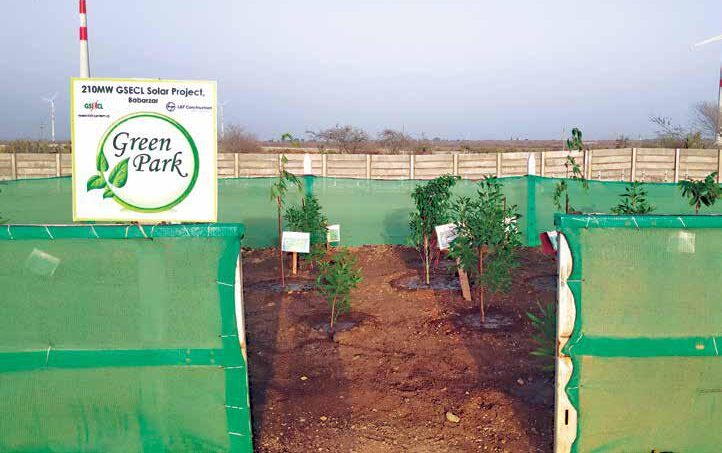From wasteland to green corridor
EHS is top priority when constructing Gujarat’s largest-capacity solar plant

PT&D IC’s Renewables BU is helping convert pockets of wasteland in the village of Babarzar, in Jamnagar district, Gujarat, into platforms for harnessing renewable energy. The under-construction 210 MW AC / 315 MWp DC ground-mounted, fixed-tilted solar power plant will be the highest-capacity plant of Gujarat State Electricity Company Ltd. (GSECL) that will provide renewable energy to the industrial hub of Jamnagar and to farmers in Gujarat’s Saurashtra region, aiding the development of the agricultural belt.
1,200 acres of undulating, extensively rock-filled, bushy wasteland located 52 km from the district headquarters, Jamnagar is where the project team is developing wastelands for residential buildings, plant, machinery, ancillary equipment, material, switchgears, transformers, and protection equipment. The project scope includes the development, design, engineering, supply, construction, operation, and maintenance of the power plant for a period of 10 years.
Taming the wasteland and tackling ‘ground’ realities
Filled with numerous pits, overgrown with shrubs, interrupted by windmills, areas ear-marked for future projects, roads without boundaries, and encroachments, the ground posed considerable challenges to identify border coordinates conforming to the land revenue records. For Project Manager V. R. Thanumalayan and team, the first task was to access the allocated plot and survey the boundaries. Maintaining the highest EHS standards in such a testing environment was EHS In-charge Bijay Ketan Bhuyan’s responsibility, and he is proud that the project has thus far clocked 0.76 million safe manhours.

We have ranked first in the Renewables BU’s project EHS rankings, not just once, but nine times since inception! And we have consistently scored above 85% in all third-party (Bureau Veritas), internal, cross-BU, and surprise audits.
V. R. Thanumalayan
Project Manager


“We have ranked first in the Renewables BU’s project EHS rankings, not just once, but nine times since inception!” beams Thanumalayan. “And we have consistently scored above 85% in all third-party (Bureau Veritas), internal, cross-BU, and surprise audits.”
Bijay shares the various steps they have followed to access the plot safely, starting with its survey and assessment after studying the topography, identifying potential hazards, and testing soil stability. Apart from 10,000+ manhours of training for both employees & workmen, which includes VR training, clear protocols were established, and suitable routes identified considering elevation changes, obstacles, and natural pathways to optimize travel time and minimize risks. “Our P&M team procured vehicles with appropriate offroad capabilities, specialized machinery for slope stabilization, and tools for working on uneven surfaces safely,” he informs, “and our team members working in different areas are in constant touch with each other for swift coordination, reporting of incidents, and timely response to emergencies.” While the EHS team regularly monitors the terrain conditions through periodic inspections and geotechnical assessments, they have adhered to environmental regulations and implemented measures to minimize the project’s impact on the ecosystem.

Working safely with a 45-minute tolerance
“Spread across both sides of a State Highway, we take some 45 minutes to traverse from one end of the site to the other,” explains Bijay, “and during an emergency a delay or deviation could have severe consequences. We have planned and accounted for any possible emergencies with a dedicated emergency vehicle placed at the centre of the site that can cover distances in a short time, an emergency response team, adequate contingency plans, safety measures, and communication protocols to mitigate this risk and ensure the safety of our workmen.”

The project team has introduced a Work Permit System through the SHEILD app that ensures safe and authorized execution of work. The permit lists the necessary stipulations for the work and is digitally signed off only when all prescribed special conditions have been complied with.


Spread across both sides of a State Highway, we take some 45 minutes to traverse from one end of the site to the other. We have planned and accounted for any possible emergencies to mitigate this risk and ensure the safety of our workmen.
Bijay Ketan Bhuyan
EHS In-charge

A ‘carrot & stick’ approach
Every month the Safest Site Engineer, the Safest Subcontractor, and the Safest Workman are awarded to motivate personnel and promote a safety culture. Conversely, EHS-related failures are identified by the Site Engineer, EHSO, or CEHSC/M through EHS inspection, incident investigation, and analysis of monthly EHS performance using the SHEILD app.

“We identify defaulters during dayto-day activities at the workplace,” reveals Hariprasath R., EHS Engineer, “and view all obvious deficiencies seriously, reprimanding the person appropriately. Repeated noncompliances are recorded and reported to the authorities such as the Project In-charge, COH, EHS Head, and CEHSC/M.”

We conduct daily inspections and a large housekeeping programme on Saturdays to keep the workplace clean and orderly, reducing the possibility of incidents and other dangers.
Hariprasath R
EHS Engineer


A ‘Green & Clean’ site
Every occasion of national/ cultural importance, birthdays, and visits from senior management are celebrated with planting of saplings, which is now a thriving ‘green park’ adjacent to the site office and a hit with all visitors! “The cherry on the cake was when Mr. H. K. Solanki, Chief Engineer of GSECL, visited our site,” Bijay says with a grin. “He and his team enthusiastically took part in the initiative and also offered us useful information about recent tree plantation techniques and technologies.” Not only do the team members take the initiative seriously to plant saplings, but they also take care of them, especially during the crucial first few weeks.
“We conduct daily inspections and a large housekeeping programme on Saturdays,” informs Hariprasath, “to keep the workplace clean and orderly, reducing the possibility of incidents and other dangers.” Each of the 18 blocks at the site has a shade and rest shed with drinking water that is replenished daily. “From ‘Swachh Bharat Abhiyan’ to ‘Swachh Site Abhiyan’, we stand for our Prime Minister’s vision of a clean India!” he adds with a thumbs-up.
Taking social responsibility
“Environment conservation and community development are not the optional ‘extra’ that companies take up after taking care of business.” Taking SNS’s message to heart, the project team has organized various CSR programmes such as vaccination camps during the pandemic, a blood donation camp, and an interactive programme for students focusing on the five elements of health – physical, mental, social, emotional, and spiritual.
“The lion’s share of the mighty workforce working towards energy security of the region is made up of none other than the immediate beneficiaries of the project, and around 80% of the workmen are locals,” remarks Thanumalayan, revealing how the project has opened new employment opportunities for the population living in the country’s furthest reaches.
“Customer delight is our best advertisement,” notes Bijay as he signs off. “On the occasion of the 52nd National Safety Day on 4 March 2023, the Chief Engineer was all praise for our virtual training module and the world-class EHS practices that is the L&T trademark, urging all contractors to learn from our practices and implement them across all GSECL sites.” A testament to the fact that L&T’s work speaks for itself!